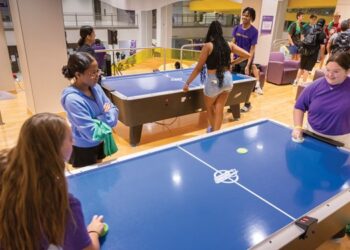Campus Recreation provides an enhanced opportunity for the development of leadership capacity among student employees. It is essential that campus recreation professionals not only foster this culture of leadership development, but also asses it and use it as a tool to communicate the value of campus recreation to the entire university community.
In their sourcebook “New Directions for Student Leadership,” Cara McFadden and Dr. Don Stenta discuss the notion of leadership development in the campus recreation setting through the framework of various leadership theories and models, including the Social Change Model of Leadership Development, the Multi-Institutional Study of Leadership, the Leadership Identity Model, the Relational Leadership Model and several others.
However, while these leadership models help to explain student leadership development, many campus recreation professionals are unaware of their existence. This is where the NIRSA Leadership Commission comes in. “We have been educating people about the sourcebook and trying to bring practical tools and strategies to the student leadership development process that people can grasp on to,” said Mila Padgett, the director of campus recreation and wellness at the University of South Carolina Aiken and the current chair of the NIRSA Leadership Commission.

According to McFadden, assistant professor of sport and event management at Elon University, many campus recreation departments are already making leadership development among student employees a priority. They have developed programs and trainings to enhance leadership opportunities, but they are not linking it to a specific theory. “A lot of the time we are doing the work, we just aren’t connecting it to models,” explained McFadden. “A lot of time there is a fear in the word ‘theory.’ We don’t want to talk about it. But if we are able to take some of the existing things we are doing around student leadership and then understand how it connects to a model, it gives us the opportunity to assess if we are actually developing the leadership capacity in our students.”
Examine all of the programs, trainings and various other opportunities provided to student employees at your recreation center. Maybe there is already a connection with a leadership model that you are unaware of. “One of the things about our profession is we all have a variety of different degrees that we come to the table with, which is awesome,” said Padgett. “But for me, I have a Masters in Exercise Physiology, so I did not have a single class on student development theory. But my role as a director is to develop leaders. What we are finding is we need to educate individuals so they understand what student development theory is.”
For example, James Madison University has their program rooted in two different theories: The Leadership Challenge and Chickerings Theory of Identity Development. All of their student development programs and trainings link back to the foundation of those two theories. “One of the things they do to follow Chickering is a common training for all the employees no matter where they work in the department,” said Padgett. “They start their big fall training by bringing everyone in the same space, sharing the same message, from the same people, so that everyone is on the same page. One of Chickering’s theories is that you need to be training your people and sharing the same exact message, on the same day, at the same time, because you can change what you say depending on the day.”
It is also important to find out if other departments within the university are already using a leadership development model that might fit within your facility as well. “I know at Elon they had adopted the Social Change model, so all groups within Student Life work towards infusing the Social Change model in their department,” added McFadden. “So, the first step is seeing if the university has something they are trying to do. Then look at the variety of models and decide what best fits your department, because not everything is going to fit well with the environment. Know the uniqueness of the environment and do not get caught up in wanting to do it all.”

Once you have instituted various leadership development opportunities and connected them with a model, the next step is assessing the effectiveness and learning outcomes. Padgett suggested a variety of assessment tools you can use to assess the impact you are having on your student employees. It could be as simple as exit interviews with seniors and regular employee performance reviews — once a semester or once a year.
“It is important to evaluate them critically and honestly, then hopefully you can see progress,” said Padgett. “I think sometimes the hardest thing is giving honest feedback on where they are. We have to be a little more specific on where they are doing a good job — for example work ethic, problem solving — and then give them detailed areas where they need to improve. Then you can show that progression. If you just say good job, you can’t really show progression.”
While implementing a leadership model might seem like a daunting task, as McFadden and Padgett explained, it is an essential way to ground your leadership development efforts within the department and even across campus. “You can’t be afraid to start and you have to understand that any little piece that you start with matters,” explained Padgett. “You may have to take little pieces and implement something every semester or every year. You have to understand the big picture and where you are trying to head, but you don’t have to put it all together at one time. I think that is where it becomes very overwhelming for people. They don’t know how to implement an entire theory. But as long as you know the outcome, then you can put in small steps to reach that goal. You just have to start.”










